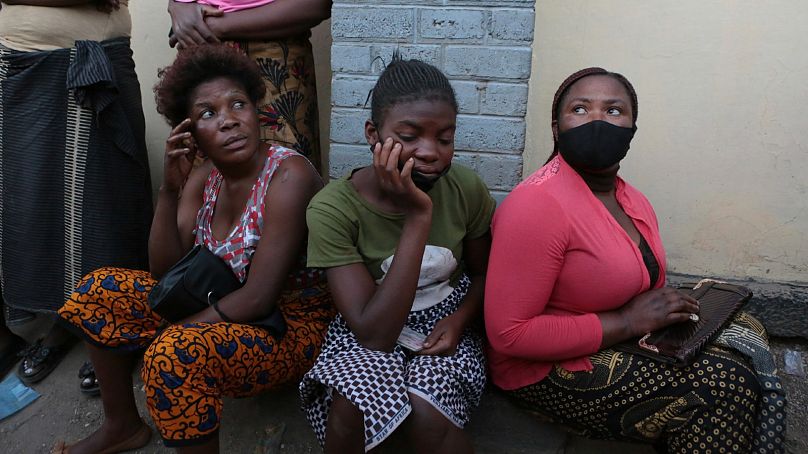As Spain debates days off work for period pain, here’s a list of the countries that already tried offering "menstrual leave".
Spain’s plan to introduce paid "menstrual leave" in the workplace, if approved in parliament, would mark a European first.
But the proposal has already sparked an intense debate over whether it could help or hinder women at work.
"It's such a lightning rod for feminists," Elizabeth Hill, an associate professor at the University of Sydney, told Euronews Next.
Hill, who has extensively studied menstrual leave policies worldwide, says there have been several "eras" and motivations for them over the past 100 years.
Here’s a list of the countries that had a go at offering menstrual leave, and some insight into how it was received.
The Soviet Union’s pronatalist push
In the first comprehensive study on the topic published last year, Hill and her colleagues were able to retrace the first legislation on menstrual leave back to the Soviet Union where it was introduced in 1922.
The Bolshevik menstrual policy was directed at women working in factory jobs, providing them with two to three monthly days of fully paid leave during their period.
"You can really read the Soviet Union's design and experience within a frame of pro-natalist policy," Hill explained. "It's very much about protecting women's fertility and their role as mothers, even as they are workers".
It’s unclear how the policy actually fared and whether it was overturned before or after the collapse of the Soviet Union in 1991.
Menstrual leave reappeared in the Russian political debate in 2013 but the proposal, which was phrased in somewhat paternalistic terms - focusing on managing the "unwieldy" female body and psyche - failed to take off and even upset feminists and human rights advocates.
Japan: Menstrual leave as an industrial right
Japan became the second country to introduce menstrual leave in 1947. The thinking at the time was to grant women an industrial right where the conditions of work and workplaces are inadequate.
"So again, you've got women in the workplace, but you don't have adequate provision of, say, loos, bathrooms for women workers," Hill said.
Article 68 of Japan’s Labour Standards Act, which remains in force 75 years on, states: "When a woman for whom work during menstrual periods would be especially difficult has requested to leave, the Employer shall not have said woman work on days of said menstrual period".
Employers have discretion and can grant leave by calendar day, half-day, or by the hour. Women workers simply have to request it, and no medical documentation is required.
But the policy has proven to be controversial and fuelled fears of discrimination with a recent survey by Nikkei Intelligence Group finding less than 10 per cent of Japanese women take period leave.
Indonesia: A divisive policy
Indonesia followed suit in introducing menstrual leave in 1948, also treating it as an industrial right for women miners or factory workers in the absence of adequate bathrooms or sanitation.
While it may have provided relief to blue-collar workers, survey data showed women employed in the services sectors such as retail and finance rarely took menstrual leave and tended to view it as an embarrassment.
In the 1990s, the Association of Indonesian Businesswomen even called for a repeal of the policy, deeming it "contradictory to the aims of women’s emancipation".
A reform in 2003 watered down the rules; the law no longer mandates two days of paid leave but instead makes the policy subject to negotiation between employers and unions.
South Korea's 'reverse sexism'
In 2001, South Korea ratified article 73 of its Labour Standards Act which provides for one day of unpaid leave per month awarded at the employee’s request.
All female employees are entitled to the benefit, irrespective of their job status or how long they’re worked in the company.
Employers who violate the law are liable for up to two years in prison or a fine of up to 10 million won (around €7,500).
However, there, too, the topic is controversial. Some male workers have publicly argued against menstrual leave as a form of “reverse sexism” and women are reportedly reluctant to ask for it.
In 2012, Sung Jae-gi, the head of South Korean men's rights group Man of Korea, posted a scathing comment on Twitter: "You [women] should be ashamed of yourselves. Why are you making such a fuss about menstruating when the nation's birthrate is the lowest in the world?"
Taiwan: Three days a year
Menstrual leave was first introduced in Taiwan in 2002 and amended in 2013. The policy allows a maximum of three days of menstrual leave per year, with employees receiving half of their regular wage.
Under the original policy, women were entitled to menstrual leave, but this was integrated into the 30 days of sick leave which also provided for half pay. As a result, if a woman claimed three days menstrual leave, that would only leave 27 days of common sick leave for the year.
The new scheme, established in 2013, sought to fix this, and women are now entitled to three days of menstrual leave per year at half pay, on top of the 30 days of common sick leave. This means women can claim "up to 33 days of health-related leaves per year".
But there’s a catch: if an employee takes more than 30 days of sick leave in total then the additional three days are unpaid.
Zambia’s 'Mother's Day'
Menstrual leave was enshrined in the law of this southern African country in 2017.
It allows women workers to take one day of leave from work each month without having to produce a medical certificate or give a reason to their employer.
Colloquially referred to as "Mother’s Day" - even though it applies to all women, whether or not they have children - the policy largely operates on an informal basis, with women simply allowed to call in on the day to say they are taking that leave.



















